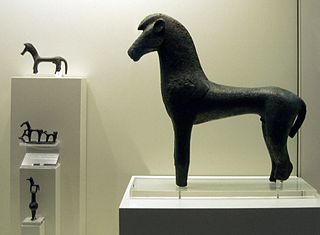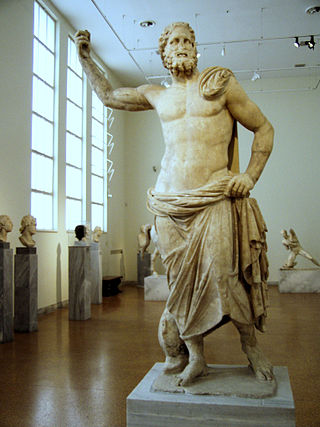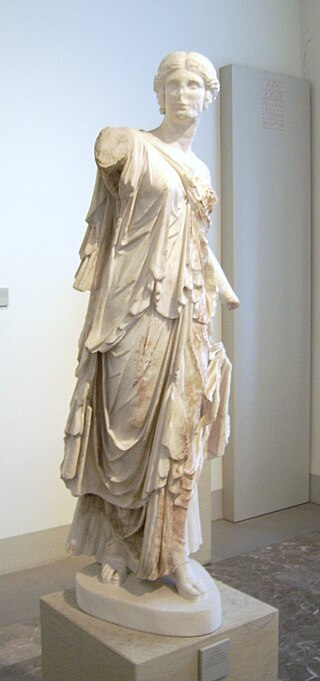Description
The two figures are connected to one another. The larger figure, Zeus, holds the smaller figure, clutching him tightly with his right arm. Zeus's right arm went under Ganymede's own right arm, which is broken below the shoulder and is almost entirely lost. In his left hand, Zeus holds a wooden walkingstick. Zeus wears a long tunic which hangs loosely over his left arm and his hips. His upper body is exposed, but the tunic completely covers his back. The legs of the god are in a striding posture, his left leg poking out through a gap in his tunic. He is barefoot. Part of the left leg is poorly preserved, like the edge of the tunic and there is damage to his right foot, left elbow and head. His damaged head, which is made from a separate piece of clay, is decorated with a hat with orderly locks of hair issuing from underneath it. The sharpness of his chin is striking. His restrained smile is a late form of the so-called "archaic smile".
The completely naked figure of Ganymede is more fragmentary than Zeus and has been reconstructed from a large number of pieces. In addition to his arm, part of his chest, his feet and his pubic region are missing. Ganymede also wears a hat and has the same carefully arranged corkscrew locks underneath it. The long hair hangs down over his neck and shoulders. His expression is strained, serious and pensive, in strong contrast to Zeus' satisfied expression. In his left hand Ganymede holds a hen, a common gift associated with pederasty at the time.
Remnants of paint survive in many places, particularly Zeus' red-brown tunic with dark brown lines at the edges and his black beard, hair and hat. The god stands on an architectural base in the shape of a gable.

The Statue of Zeus at Olympia was a giant seated figure, about 12.4 m (41 ft) tall, made by the Greek sculptor Phidias around 435 BC at the sanctuary of Olympia, Greece, and erected in the Temple of Zeus there. Zeus is the sky and thunder god in ancient Greek religion, who rules as king of the gods of Mount Olympus.

The sculpture of ancient Greece is the main surviving type of fine ancient Greek art as, with the exception of painted ancient Greek pottery, almost no ancient Greek painting survives. Modern scholarship identifies three major stages in monumental sculpture in bronze and stone: the Archaic, Classical (480–323) and Hellenistic. At all periods there were great numbers of Greek terracotta figurines and small sculptures in metal and other materials.

The Temple of Zeus at Olympia was an ancient Greek temple in Olympia, Greece, dedicated to the god Zeus. The temple, built in the second quarter of the fifth century BC, was the very model of the fully developed classical Greek temple of the Doric order.

The Apollo of Veii is a life-size painted terracotta Etruscan statue of Aplu (Apollo), designed to be placed at the highest part of a temple. The statue was discovered in the Portonaccio sanctuary of ancient Veii, Latium, in what is now central Italy, and dates from c. 510 - 500 BC. It was created in the so-called "international" Ionic or late-archaic Etruscan style.

The Artemision Bronze is an ancient Greek sculpture that was recovered from the sea off Cape Artemision, in northern Euboea, Greece. According to most scholars, the bronze represents Zeus, the thunder-god and king of gods, though it has also been suggested it might represent Poseidon. The statue is slightly over lifesize at 2.09 meters, and would have held either a thunderbolt, if Zeus, or a trident if Poseidon. The empty eye-sockets were originally inset, probably with bone, as well as the eyebrows, the lips, and the nipples. The sculptor is unknown. The statue is a highlight of the collections in the National Archaeological Museum of Athens.

In Greek mythology and ancient religion, Nike; Ancient Greek: Νίκη, romanized: Nike, lit. 'victory'; pronounced[nǐː.kɛː], modern: ) is the goddess who personifies victory in any field including art, music, war, and athletics. She is often portrayed in Greek art as Winged Victory in the motion of flight; however, she can also appear without wings as "Wingless Victory" when she is being portrayed as an attribute of another deity such as Athena.

The Archaeological Museum of Olympia is one of the principal museums of Greece, located in Olympia. It is overseen by the Ministry of Culture and Sports, and, as of 2009, is directed by Georgia Xatzi. When the original building was completed and opened in 1888, it was the first museum in Greece outside of Athens.

The Apollon of Olympia was part of the group of sculptures found in the west pediment of the Temple of Zeus at Olympia. Its original location also provides it with another name: the Apollon from the west pediment. It is one of the most important statues of the Severe style or early Classical style, dating from ca. 460 BCE. The statue is currently in the Archaeological Museum of Olympia.

The Pan Painter was an ancient Greek vase-painter of the Attic red-figure style, probably active c. 480 to 450 BC. John Beazley attributed over 150 vases to his hand in 1912:
Cunning composition; rapid motion; quick deft draughtsmanship; strong and peculiar stylisation; a deliberate archaism, retaining old forms, but refining, refreshing, and galvanizing them; nothing noble or majestic, but grace, humour, vivacity, originality, and dramatic force: these are the qualities which mark the Boston krater, and which characterize the anonymous artist who, for the sake of convenience, may be called the 'master of the Boston Pan-vase', or, more briefly, 'the Pan-master'.

In Greek mythology, Ganymede or Ganymedes is a divine hero whose homeland was Troy. Homer describes Ganymede as the most beautiful of mortals and tells the story of how he was abducted by the gods to serve as Zeus's cup-bearer in Olympus.
[Ganymedes] was the loveliest born of the race of mortals, and therefore
the gods caught him away to themselves, to be Zeus' wine-pourer,
for the sake of his beauty, so he might be among the immortals.
The Sounion Kouros is an early archaic Greek statue of a naked young man or kouros carved in marble from the island of Naxos around 600 BCE. It is one of the earliest examples that scholars have of the kouros-type which functioned as votive offerings to gods or demi-gods, and were dedicated to heroes. Found near the Temple of Poseidon at Cape Sounion, this kouros was found badly damaged and heavily weathered. It was restored to its original height of 3.05 meters (10.0 ft) returning it to its larger than life size. It is now held by the National Archaeological Museum of Athens.

Ancient Greek art stands out among that of other ancient cultures for its development of naturalistic but idealized depictions of the human body, in which largely nude male figures were generally the focus of innovation. The rate of stylistic development between about 750 and 300 BC was remarkable by ancient standards, and in surviving works is best seen in sculpture. There were important innovations in painting, which have to be essentially reconstructed due to the lack of original survivals of quality, other than the distinct field of painted pottery.

The Dionysus Cup is the modern name for one of the best known works of ancient Greek vase painting, a kylix dating to 540–530 BC. It is one of the masterpieces of the Attic black-figure potter Exekias and one of the most significant works in the Staatliche Antikensammlungen in Munich.

The Winged Gorgoneion is a bronze shield decoration from the first half of the 6th century BC, which served as an apotropaion on a shield. It was found during the excavations at Olympia and is now in the Archaeological Museum of Olympia.

The Korai of the Acropolis of Athens are a group of female statues (Korai), discovered in the Perserschutt of the Acropolis of Athens in the last quarter of the nineteenth century, all of the same typology and clear votive function. Through them it is possible to trace the stylistic evolution of Archaic Attic sculpture for almost a century, from 570 to 480 BC. This demonstrates in particular the beginning and development of Ionian influence on Athenian art of the second half of the 6th century BC. This was the period when Ionian elements first appear in the architectural works of the Peisistratids and close connections between Ionia and Athens developed. Towards the end of the 6th century BC this influence is seen to be overcome, or rather absorbed, and a new style is born, the so-called Severe style, with increasing Peloponnesian influence.

The Sculpture of a Horse is an Archaic bronze sculpture. It was discovered at Olympia during excavations in 1939 and is now displayed in the Archaeological Museum of Olympia. The sculpture's creation is dated to the early 7th century BC.

The Poseidon of Melos is a statue of Poseidon in the National Archaeological Museum, Athens (NAMA), with an inventory number 235, which is dated to the last quarter of the second century BC. It is believed to date to the Hellenistic Period.

Dancer of Pergamon is the modern name for a Hellenistic statue of a woman from Pergamon, which is now kept at the Antikensammlung Berlin.

The pediments of the Parthenon are the two sets of statues in Pentelic marble originally located as the pedimental sculpture on the east and west facades of the Parthenon on the Acropolis of Athens. They were probably made by several artists, including Agoracritos. The master builder was probably Phidias. They were probably lifted into place by 432 BC, having been carved on the ground.

The Apollo Omphalos is an ancient Roman marble copy of a Greek original bronze sculpture in typical early Archaic period style, depicting Apollo, the Greek god of music, medicine, and prophecy. Today it is housed in the National Archaeological Museum of Athens, in Greece. The sculpture was found in several fragments which were put together, and bears several signs of damage.



















